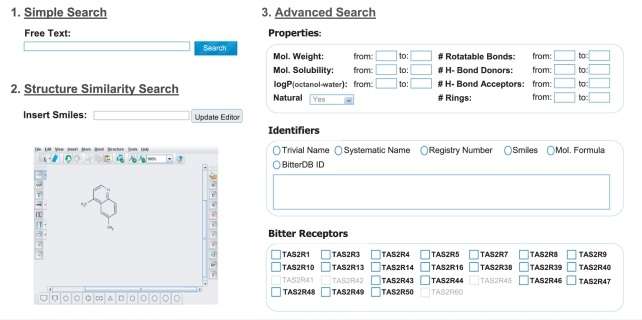BitterDB
| Content | |
|---|---|
| Description | bitter compounds. |
| Contact | |
| Research center | The Hebrew University of Jerusalem Rehovot, Israel. |
| Laboratory | The Robert H Smith Faculty of Agriculture |
| Authors | Ayana Wiener |
| Primary citation | Wiener & al. (2012)[1] |
| Release date | 2011 |
| Access | |
| Website | http://bitterdb.agri.huji.ac.il |
| Tools | |
| Web | blast |
The BitterDB is a database of compounds that were reported to taste bitter to humans.[1]
Summary
Basic taste qualities like sour, salty, sweet, bitter and umami serve specific functions in identifying food components found in the diet of humans and animals, and are recognized by proteins in the oral cavity. Recognition of bitter taste and aversion to it are thought to protect the organism against the ingestion of poisonous food compounds, which are often bitter. Bitter taste receptors are expressed not only in the mouth but also in extraoral tissues. BitterDB database, available at http://bitterdb.agri.huji.ac.il/bitterdb/, includes over 550 compounds that were reported to taste bitter to humans. The compounds can be searched by name, chemical structure, similarity to other bitter compounds, association with a particular human bitter taste receptor, and so on. The database also contains information on mutations in bitter taste receptors that were shown to influence receptor activation by bitter compounds.
Database Overview
Bitter Compounds

BitterDB currently contains more than 550 compounds that were cited in the literature as bitter. For each compound, the database offers information regarding its molecular properties, references for the compound’s bitterness, including additional information about the bitterness category of the compound (e.g. a ‘bitter-sweet’ or ‘slightly bitter’ annotation), different compound identifiers (smiles, CAS registry number, IUPAC systematic name), an indication whether the compound is derived from a natural source or is synthetic, a link to the compound’s PubChem entry and different file formats for downloading (sdf, image, smiles). Around 100 bitter compounds have been experimentally linked to their corresponding human bitter taste receptors. For those compounds, BitterDB provides additional information, including links to the publications indicating these ligand–receptor interactions, the effective concentration for receptor activation and/or the EC50 value and links to the associated bitter taste receptors entries in the BitterDB.
Querying and Browsing
Bitter compounds can be queried and browsed in different ways. For example, 'advanced search' option allows user to retrieve compounds that fit different criteria, such as a combination of specific physical properties or a combination of associated human bitter taste receptors. In addition to the querying options the user can browse through a sort-able table with all the BitterDB compounds.
Bitter Taste Receptors
In addition, BitterDB contains data about the 25 known human bitter taste receptors. Several properties are displayed for each receptor. The bitter taste receptors can be searched using different criteria: name, known ligands and UniProt accession number. Using a table that presents all the bitter taste receptors and some information about them, the user can browse and also sort by various options, such as the number of bitter ligands associated with the receptor.
Local BLAST Service and Global Alignment
BitterDB offers two additional features: a local BLAST service to determine the local similarity between a query sequence and the different human bitter taste receptors, and a global alignment of the 25 human bitter taste receptors. The alignment was generated using ClustalW2, and displays the secondary structure of each receptor, as predicted by the TOPCONS server.
Users Can Upload Bitter Compounds
BitterDB offers an ‘upload’ option, by which the users are encouraged to submit information about bitter compounds. These data will be reviewed by the authors and uploaded to the database accordingly. The users can join the mailing list in order to receive database updates.
See also
References
- 1 2 Wiener, Ayana; Shudler Marina; Levit Anat; Niv Masha Y (Jan 2012). "BitterDB: a database of bitter compounds". Nucleic Acids Res. England. 40 (Database issue): D413–9. doi:10.1093/nar/gkr755. PMC 3245057
 . PMID 21940398.
. PMID 21940398.